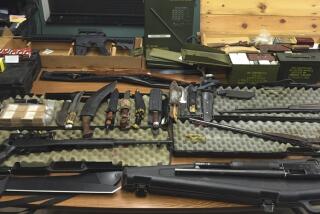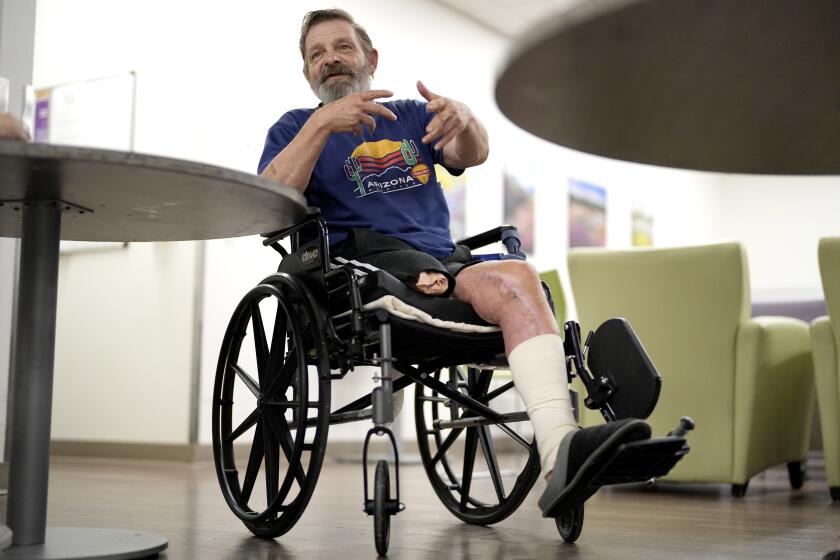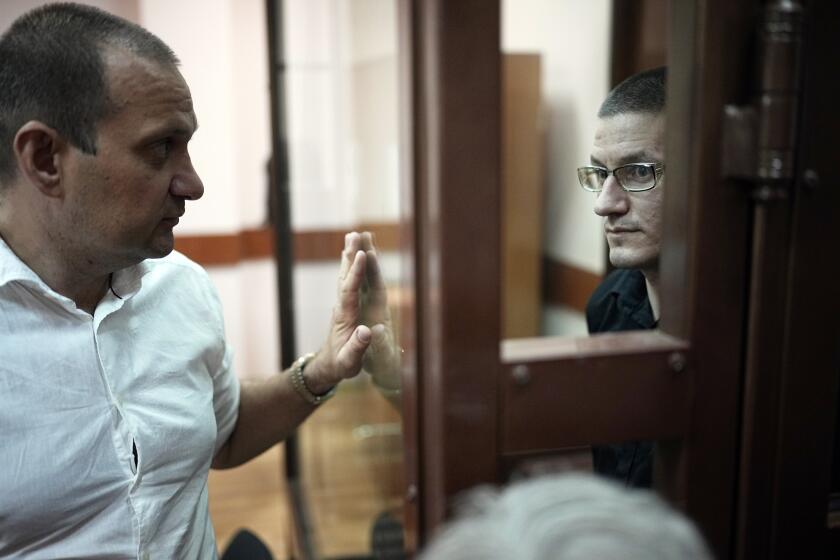A Child Lost to Racial Hate Lost Again in Birmingham
Every few minutes, it’s like another bomb going off.
Above her headstone, one after another, jets from the nearby airport re-create the last sound she heard, their booming engines recalling the tragedy that befell her 34 years ago, a tragedy that still reverberates.
Addie Mae Collins was 14 when she became one of the civil rights movement’s most lamented victims. On Sept. 15, 1963, she and three other girls were killed by Ku Klux Klan members who planted dynamite beneath the Sixteenth Street Baptist Church, where the girls were getting dressed for Sunday morning services.
The Rev. Martin Luther King Jr. spoke at the funeral three days later, telling 8,000 mourners that Addie and the other girls were “modern heroines of a holy crusade.” But today, as the nation commemorates King’s birthday, Addie Mae Collins is more than a martyr. She’s also a mystery.
A baffling discovery was made last week when Addie’s sister, Sarah, ordered her grave opened. Sarah wanted Addie removed from the lumpy field of decrepit trees and crumbling headstones, which was abandoned 20 years ago. She wanted Addie reburied in a better cemetery, where weeds don’t grow shin-high in summertime, where planes don’t drown out your conversations with an older sister who never had a chance.
But when workers opened Addie’s grave, they were horrified to find nothing. They dug 2 feet deeper, then 2 feet wider. Still nothing. No body was there to accompany the gray marker that read: “Addie Mae Collins . . . She Died So Freedom Might Live.”
“I was really shocked,” said Sarah. “It was really hurtful too. I’ve been going there, talking to her for years. Then to find out that she really wasn’t there. I knew her spirit was with the Lord, but I never thought her remains weren’t there.”
“At times, life is hard,” King said at Addie’s funeral, “as hard as crucible steel.”
But what would he have made of this latest hardship? Of losing a beloved sister twice? And on this of all weekends.
“This is one of those weekends when people are reflecting on the civil rights movement,” said an obviously shaken Rep. Earl F. Hilliard (D-Ala.), the first black congressman from Alabama since Reconstruction. “This is a tragedy. It’s a loss to history.”
The fear is that someone took Addie’s remains. Over time, the cemetery has been a playground for countless vandals, both casual and deliberate. Or else someone connected with the cemetery moved her, for who knows what reason. A spokesman for Poole Funeral Home, which reportedly handled the burial 34 years ago, refused to comment, but no one seems sure if Poole even has the cemetery records, or if such records still exist.
Even the name of the cemetery isn’t certain. Newspapers call it Greenwood; history books say Woodlawn.
The most likely scenario seems to be that Addie’s grave wasn’t accurately marked at the time of her death. According to one book about the bombing and its aftermath, “Until Justice Rolls Down,” Addie’s parents could not afford a proper headstone. Now that Addie’s sister can, the parents and everyone else who might say where Addie lies has joined her underground.
Hilliard, whose press secretary gave the inscribed marker as a gift to Addie’s family, said a “monumental effort” was being made to retrace the steps of mourners who swarmed through the cemetery so many years ago, but he wasn’t specific about that effort. “I just hope it’s successful,” he said.
It was a pivotal moment in American history when the bomb went off at Sixteenth Street Baptist Church, turning part of the beloved local landmark into a pile of bricks.
Three weeks earlier, King had marched on Washington and delivered his “I Have a Dream” speech. Two months later, President Kennedy was killed. With Birmingham public schools facing a federal court order to admit black students, the city and the nation were trembling with racial tension.
Addie’s sister Sarah lost an eye that morning. She’d been standing across the church basement from her sister when suddenly the world erupted. Lying in a hospital bed for days, both eyes bandaged, she was unable to attend Addie’s funeral.
Another sister, Janie Gaines, attended the funeral but never again visited the cemetery. She never so much as laid a flower there until last week, she told a Birmingham newspaper, because the pain was just too great.
The pain promises to become still greater and fresher when news spreads that a central figure from the civil rights era isn’t resting in peace. As workers clambered over the cemetery Saturday afternoon, searching for Addie, her face filled a TV screen at the rebuilt church--along with the faces of fellow victims Denise McNair, 11, Carole Robertson, 14, and Cynthia Wesley, 14--as dozens of visitors viewed a documentary about the bombing.
But this particular Saturday, the documentary had a somber postscript. Tara Walton, a tour guide, informed the crowd that the remains of one of the victims were missing.
Many gasped.
“Heaven’s sake!” cried a woman.
“Oh no!” said another.
The visitors then peppered Walton with questions, none of which she could answer. Are vandals responsible? Can anything be done? How long has the little girl been gone?
Nervously, Walton said only that talks had been underway to bring all four girls back to the church, to rebury them together in a special memorial area, but that those talks were now indefinitely on hold.
If Addie’s remains can be found, it may be due largely to the efforts of Jim Stokes, manager of the Superior Concrete Co. He’s the man Sarah hired to open the grave, and he’s the only man now willing to search for the body.
“I thought we were coming to a conclusion of this situation,” he said the other day, standing in the forlorn cemetery, peering at the ground. “Instead, we’ve just made the situation worse.”
Stokes has consulted various old-timers and longtime Birmingham residents with sharp memories, hoping one will remember that funeral in vivid and precise detail. But already he’s discovered what historians have long known: When it comes to memory, time is the ultimate vandal.
“You get 10 people out here,” he said, “and they’ll point in 10 different directions. Some say the body’s in this vicinity. Some say it’s in that vicinity.”
He walked back and forth, examining the plane of the ground like a golfer, squinting at every name etched in the old stones. He was 12 when the bombing happened, and he remembers little about it.
“I wish I’d paid attention,” he said, “so maybe I could solve this now.”
Next to the place Addie was supposed to be buried is the grave of Cynthia Wesley. Below Cynthia is an unmarked, muddy mound where Stokes suspects Addie may be. But he needs Sarah’s permission to dig again, and even then he fears exhuming the wrong remains, inadvertently reopening another family’s grief.
Idly, he studied the epitaph on the nearby grave of an unrelated person.
“Gone but Not Forgotten,” he read. “That’s a for-sure statement.”
Behind him, however, he failed to notice the epitaph on a large crypt, a quote from the Book of Psalms:
“He is at my right hand. I shall not be moved.”
More to Read
Start your day right
Sign up for Essential California for news, features and recommendations from the L.A. Times and beyond in your inbox six days a week.
You may occasionally receive promotional content from the Los Angeles Times.






